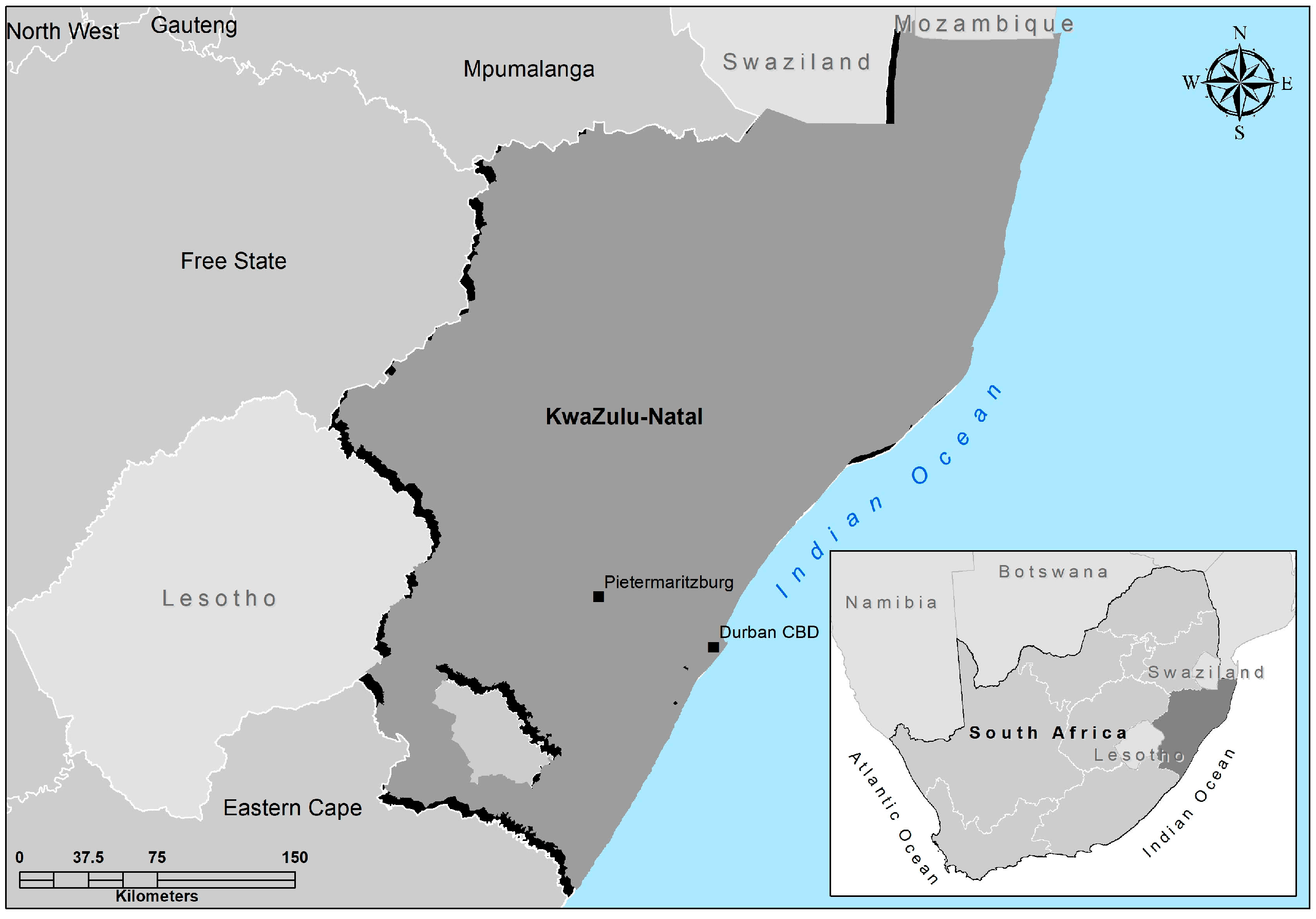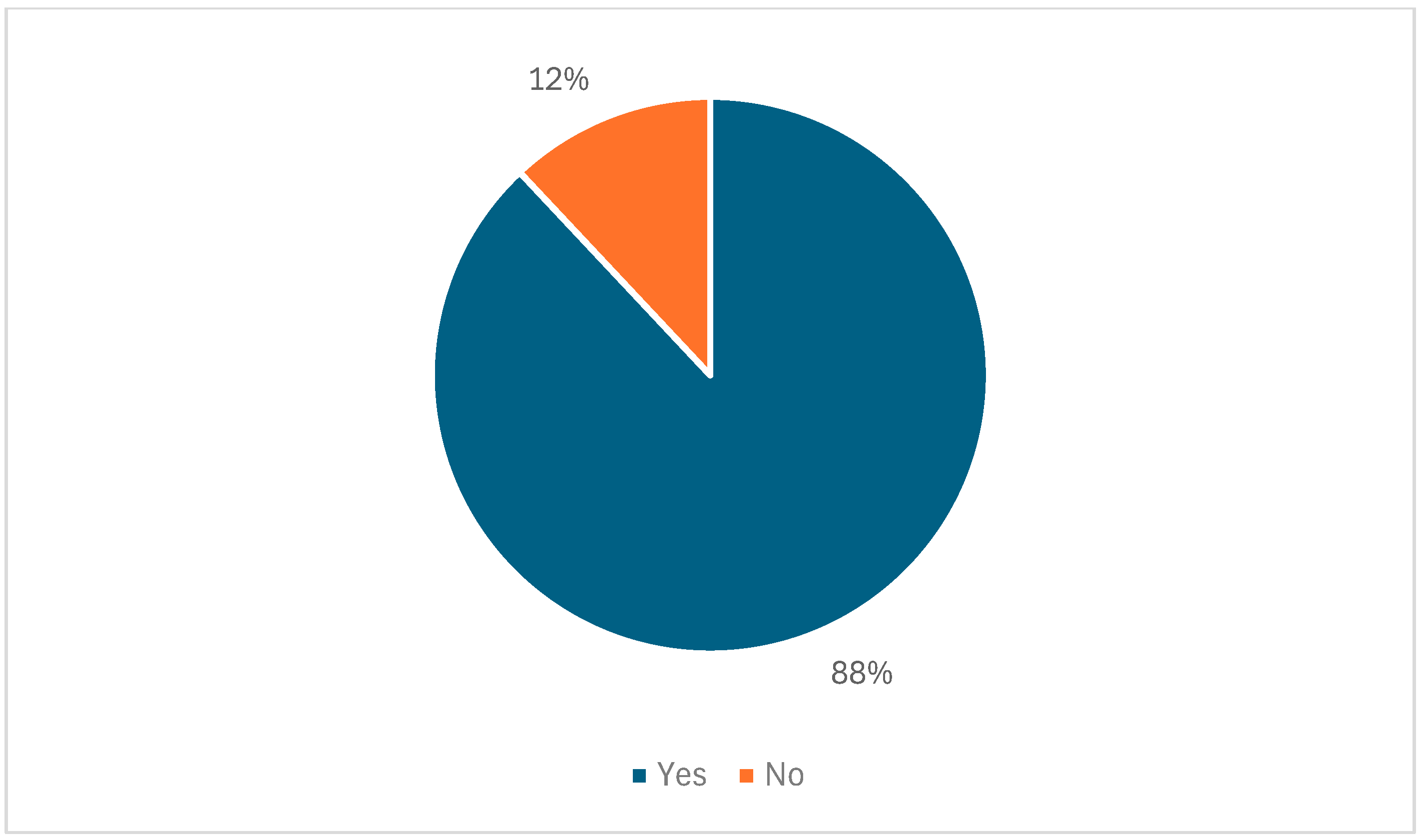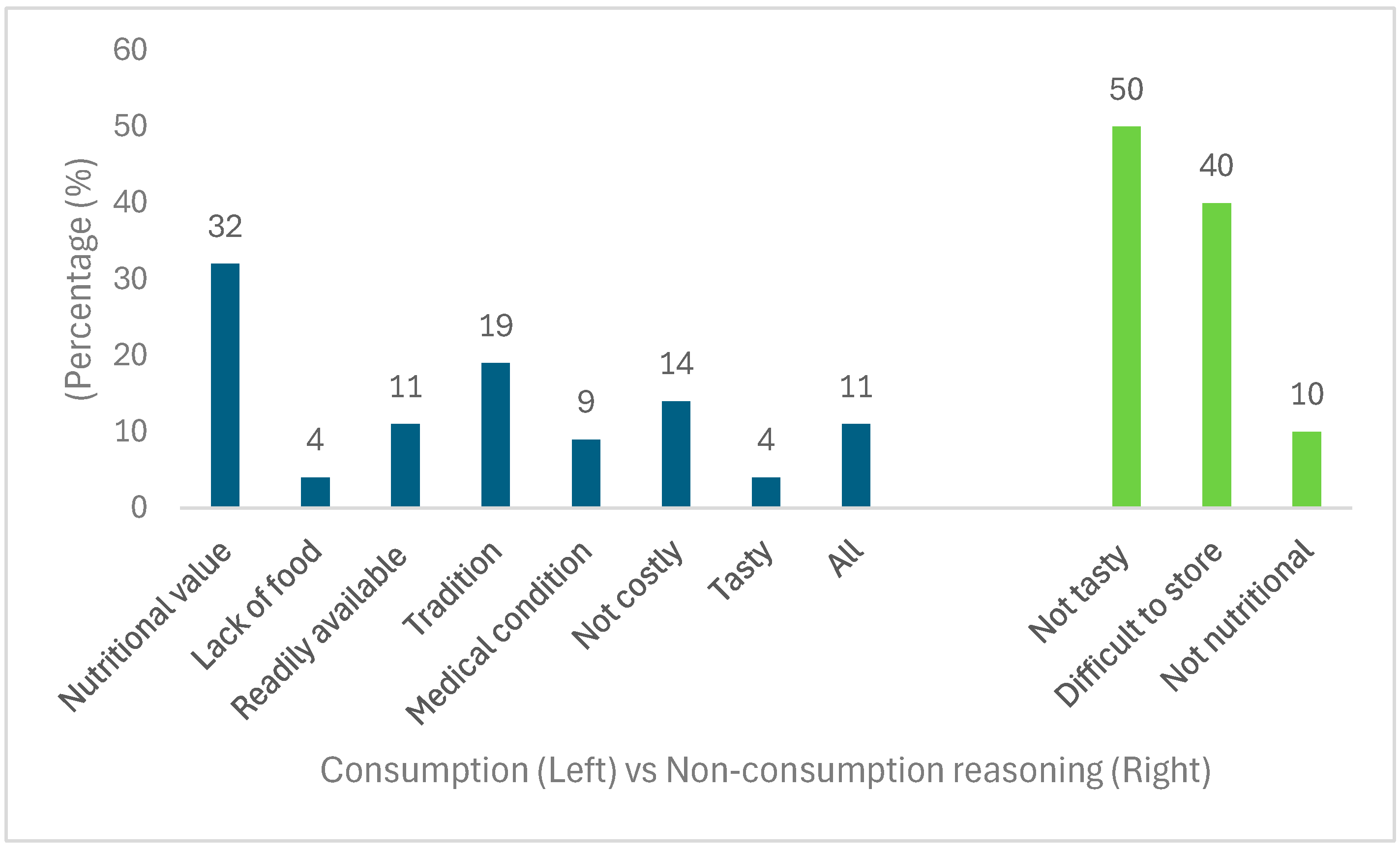Factors Associated with the Consumption of Indigenous Crops Among Farming Households in KwaZulu-Natal, South Africa
Abstract
1. Introduction
2. Materials and Methods
3. Analytical Framework
3.1. Binomial Logit Regression to Investigate the Determinants of Consumption of Indigenous Crops
3.2. Justification for Proposed Variables
4. Results and Discussion
4.1. Cultivated Versus Purchased Crops Among Farming Households
- Insufficient yield from current cultivation practices to meet household demands;
- Limited crop diversification due to monocropping practices, creating gaps in household food availability;
- Inadequate access to agricultural knowledge and support systems necessary for successful farming and market participation.
4.2. Consumption of Indigenous Crops
4.3. Determinants of Indigenous Crops’ Consumption Among Farming Households
5. Conclusions and Recommendations
- Educational and awareness initiatives
- Develop structured training programs for farmers, focusing on indigenous crop cultivation techniques;
- Implement school-based educational programs to familiarize younger generations with indigenous crops;
- Create multimedia awareness campaigns highlighting the nutritional and economic benefits of indigenous crops;
- Establish demonstration farms in communities to showcase successful indigenous crop cultivation.
- Market development and economic support
- Create dedicated market spaces for indigenous crop trading;
- Develop value-addition programs for indigenous crop products;
- Establish price support mechanisms for indigenous crop producers;
- Facilitate connections between farmers and institutional buyers (schools, hospitals, and prisons).
Author Contributions
Funding
Institutional Review Board Statement
Informed Consent Statement
Data Availability Statement
Conflicts of Interest
References
- Moallemi, E.A.; Eker, S.; Gao, L.; Hadjikakou, M.; Liu, Q.; Kwakkel, J.; Reed, M.; Obersteiner, M.; Guo, Z.; Bryan, B.A. Early systems change necessary for catalyzing long-term sustainability in a post-2030 agenda. One Earth 2022, 5, 792–811. [Google Scholar] [CrossRef]
- Mabhaudhi, T.; Chibarabada, T.; Chimonyo, V.G.; Murugani, V.G.; Pereira, L.M.; Sobratee, N.; Govender, L.; Slotow, R.; Modi, A.T. Mainstreaming underutilized indigenous and traditional crops into food systems: A South African perspective. Sustainability 2018, 11, 172. [Google Scholar] [CrossRef] [PubMed]
- Soto-Gómez, D.; Pérez-Rodríguez, P. Sustainable agriculture through perennial grains: Wheat, rice, maize, and other species. A. review. Agric. Ecosyst. Environ. 2022, 325, 107747. [Google Scholar] [CrossRef]
- Erenstein, O.; Jaleta, M.; Mottaleb, K.A.; Sonder, K.; Donovan, J.; Braun, H.J. Global trends in wheat production, consumption and trade. In Wheat Improvement: Food Security in a Changing Climate; Springer International Publishing: Cham, Switzerland, 2022; pp. 47–66. [Google Scholar]
- Onomu, A.R. Pitfalls and potential pathways to commercialization of indigenous food crops, fruits, and vegetables in Africa. Asian J. Agric. Rural. Dev. 2023, 13, 25–38. [Google Scholar] [CrossRef]
- Borelli, T.; Hunter, D.; Padulosi, S.; Amaya, N.; Meldrum, G.; de Oliveira Beltrame, D.M.; Samarasinghe, G.; Wasike, V.W.; Güner, B.; Tan, A.; et al. Local solutions for sustainable food systems: The contribution of orphan crops and wild edible species. Agronomy 2020, 10, 231. [Google Scholar] [CrossRef]
- Ndlovu, N.; Thamaga-Chitja, J.M.; Ojo, T.O. Impact of value chain participation on household food insecurity among smallholder vegetable farmers in Swayimane KwaZulu-Natal. Sci. Afr. 2022, 16, e01168. [Google Scholar] [CrossRef]
- Ngidi, M.S.C.; Zulu, S.S.; Ojo, T.O.; Hlatshwayo, S.I. Effect of Consumers’ Acceptance of Indigenous Leafy Vegetables and Their Contribution to Household Food Security. Sustainability 2023, 15, 4755. [Google Scholar] [CrossRef]
- Shembe, S.; Ngobese, N.Z.; Siwela, M.; Kolanisi, U. The potential repositioning of South African underutilised plants for food and nutrition security: A scoping review. Heliyon 2023, 9, e17232. [Google Scholar] [CrossRef]
- Aworh, O.C. African traditional foods and sustainable food security. Food Control 2023, 145, 109393. [Google Scholar] [CrossRef]
- Jacob, M.; Souza, A.M.; de Carvalho, A.M.; de Vasconcelos Neto, C.F.A.; Tregidgo, D.; Hunter, D.; de Oliveira Pereira, F.; Brull, G.R.; Kunhlein, H.V.; da Silva, L.J.G.; et al. Food Biodiversity as an Opportunity to Address the Challenge of Improving Human Diets and Food Security. Ethnobiol. Conserv. 2023, 12, 1–14. [Google Scholar] [CrossRef]
- Ayodele, V.I.; Makaleka, M.B.; Chaminuka, P.; Nchabeleng, L.M. Potential role of indigenous vegetable production in household food security: A case study in the Limpopo Province of South Africa. In I All Africa Horticultural Congress 911; CABI Agriculture and BioScience: Leuven, Belgium, 2019; pp. 447–453. [Google Scholar]
- Omotayo, A.O.; Ndhlovu, T.; Tshwene, S.C.; Olagunju, K.O.; Aremu, A.O. Determinants of Household Income and Willingness to Pay for Indigenous Plants in North West Province, South Africa: A Two-Stage Heckman Approach. Sustainability 2021, 13, 5458. [Google Scholar] [CrossRef]
- Mungofa, N.; Sibanyoni, J.J.; Mashau, M.E.; Beswa, D. Prospective role of indigenous leafy vegetables as functional food ingredients. Molecules 2022, 27, 7995. [Google Scholar] [CrossRef] [PubMed]
- Mgwenya, L.I.; Agholor, I.A.; Ludidi, N.; Morepje, M.T.; Sithole, M.Z.; Msweli, N.S.; Thabane, V.N. Unpacking the Multifaceted Benefits of Indigenous Crops for Food Security: A Review of Nutritional, Economic and Environmental Impacts in Southern Africa. World 2025, 6, 16. [Google Scholar] [CrossRef]
- Imathiu, S. Neglected and underutilized cultivated crops with respect to indigenous African leafy vegetables for food and nutrition security. J. Food Secur. 2021, 9, 115–125. [Google Scholar] [CrossRef]
- Koppmair, S.; Kassie, M.; Qaim, M. Farm production, market access and dietary diversity in Malawi. Public Health Nutr. 2017, 20, 325–335. [Google Scholar] [CrossRef]
- Takawira, K.; Mushunje, A.; Olawuyi, S.O. Determinants of Rural Household’s Food Security Status in South Africa: Lessons from Covid-19 Social Relief Grant Recipients in NIDS-CRAM Wave 5. Afr. J. Food Agric. Nutr. Dev. 2024, 15, 24205–24228. [Google Scholar]
- Coetzer, J.; Breedeveld, R. From Heritage to Health: The Many Meanings of Food in South Africa. In Geographies of Food: Global Visions of Healthy and Unhealthy Food; Springer Nature: Cham, Switzerland, 2024; pp. 137–161. [Google Scholar]
- Akinola, R.; Pereira, L.M.; Mabhaudhi, T.; de Bruin, F.M.; Rusch, L. A review of indigenous food crops in Africa and implications for more sustainable and healthy food systems. Sustainability 2020, 12, 3493. [Google Scholar] [CrossRef]
- Hadebe, S.T.; Modi, A.T.; Mabhaudhi, T. Drought tolerance and water use of cereal crops: A focus on sorghum as a food security crop in sub-Saharan Africa. J. Agron. Crop Sci. 2017, 203, 177–191. [Google Scholar] [CrossRef]
- Moyo, S.M.; Serem, J.C.; Bester, M.J.; Mavumengwana, V.; Kayitesi, E. African Green Leafy Vegetables Health Benefits Beyond Nutrition. Food Rev. Int. 2020, 37, 601–618. [Google Scholar] [CrossRef]
- Hendre, S.; Muthemba, S.; Kariba, R.; Muchugi, A.; Fu, Y.; Chang, Y.; Song, B.; Liu, H.; Liu, M.; Liao, X.; et al. African Orphan Crops Consortium (AOCC): Status of developing genomic resources for African orphan crops. Planta 2019, 250, 989–1003. [Google Scholar] [CrossRef]
- Govender, L.; Pillay, K.; Siwela, M.; Modi, A.T.; Mabhaudhi, T. Rediscovering Indigenous Crops. Resour. Mag. 2019, 26, 7–8. [Google Scholar]
- Mudau, F.N.; Chimonyo, V.G.; Modi, A.T.; Mabhaudhi, T. Neglected and underutilised crops: A systematic review of their potential as food and herbal medicinal crops in South Africa. Front. Pharmacol. 2022, 12, 809866. [Google Scholar] [CrossRef] [PubMed]
- Cloete, C.; Idsardi, E.F. Consumption of indigenous and traditional food crops: Perceptions and realities from South Africa. Agroecol. Sustain. Food Syst. 2013, 37, 902–914. [Google Scholar] [CrossRef]
- KwaZulu Natal Municipality. 2023. [WWW DOCUMENT]. Available online: http://municipalities.co.za/provinces/view/4/kwazulu-natal (accessed on 23 June 2024).
- Statistics of South Africa (StatSA). General Household Survey. Report P0318. 2019; [WWW DOCUMENT] 2019. Available online: https://www.statssa.gov.za/publications/P0318/P03182019.pdf (accessed on 16 February 2025).
- Akbar, A.; Darma, R.; Fahmid, I.M.; Irawan, A. Determinants of household food security during the COVID-19 pandemic in Indonesia. Sustainability 2023, 15, 4131. [Google Scholar] [CrossRef]
- Harris, J.K. Primer on binary logistic regression. Fam. Med. Community Health 2021, 9 (Suppl. 1), e001290. [Google Scholar] [CrossRef]
- Mengistu, S.W.; Kassie, A.W. Household level determinants of food insecurity in rural Ethiopia. J. Food Qual. 2022, 2022, 3569950. [Google Scholar] [CrossRef]
- Zemarku, Z.; Senapathy, M.; Bojago, E. Determinants of adoption of improved dairy technologies: The case of offa woreda, Wolaita zone, southern Ethiopia. Adv. Agric. 2022, 2022, 3947794. [Google Scholar] [CrossRef]
- Dzvene, A.R.; Tesfuhuney, W.; Walker, S.; Fourie, A.; Botha, C.; Ceronio, G. Farmers’ knowledge, attitudes, and perceptions for the adoption of in-field rainwater harvesting (IRWH) technique in Thaba Nchu. S. Africa. Afr. J. Sci. Technol. Innov. Dev. 2022, 14, 1458–1475. [Google Scholar] [CrossRef]
- Hawas, L.D.; Degaga, D.T. Factors affecting improved agricultural technologies adoption model in study areas in east Shewa zone, Ethiopia. J. Sustain. Dev. Afr. 2023, 25, 37–63. [Google Scholar]
- Mbhenyane, X.G. Indigenous foods and their contribution to nutrient requirements. S. Afr. J. Clin. Nutr. 2017, 30, 5–7. [Google Scholar]
- Bhengu, M.M. Gender and the Precariousness of Producing and Selling Indigenous Vegetables: A Case Study of Farmers in Northern KwaZulu-Natal. Doctoral Dissertation, University of KwaZulu Natal, Durban, South Africa, 2017. [Google Scholar]
- Ezeanya-Esiobu, C.; Taremwa, N.K.; Mugwaneza, O.; Djamali, N. Indigenous vegetable production and the economic empowerment of rural women in Africa: Reality, prospects, and challenges in Rwanda. IK Other Ways Knowing 2018, 133–156. [Google Scholar] [CrossRef]
- Zulu, S.S.; Ngidi, M.; Ojo, T.; Hlatshwayo, S.I. Determinants of consumers’ acceptance of indigenous leafy vegetables in Limpopo and Mpumalanga provinces of South Africa. J. Ethn. Foods 2022, 9, 13. [Google Scholar] [CrossRef]
- Akpa, O.M.; Okekunle, A.; Asowata, O.J.; Chikowore, T.; Mohamed, S.F.; Sarfo, F.; Akinyemi, R.; Akpalu, A.; Wahab, K.; Obiako, R.; et al. Frequent vegetable consumption is inversely associated with hypertension among indigenous Africans. Eur. J. Prev. Cardiol. 2022, 29, 2359–2371. [Google Scholar] [CrossRef] [PubMed]
- Rankoana, S.A. A Description of Small-Scale Farmers’indigenous Household Livelihood Strategies In Dikgale Community In Limpopo Province, South Africa. Eurasian J. Soc. Sci. 2022, 10, 197–203. [Google Scholar]
- Zondi, N.T.B.; Ngidi, M.S.C.; Ojo, T.O.; Hlatshwayo, S.I. Factors influencing the extent of the commercialization of indigenous crops among smallholder farmers in the Limpopo and Mpumalanga provinces of South Africa. Front. Sustain. Food Syst. 2022, 5, 777790. [Google Scholar] [CrossRef]
- Ghosh-Jerath, S.; Kapoor, R.; Barman, S.; Singh, G.; Singh, A.; Downs, S.; Fanzo, J. Traditional food environment and factors affecting indigenous food consumption in munda tribal community of Jharkhand, India. Front. Nutr. 2021, 7, 600470. [Google Scholar] [CrossRef]
- Andani, A. Welfare Effects of the Production of Indigenous Food Crops in Farming Communities in the Northern Region of Ghana. South Asian J. Soc. Stud. Econ. 2020, 8, 35–45. [Google Scholar] [CrossRef]
- Zondi, N.T.B.; Ngidi, M.S.C.; Ojo, T.O.; Hlatshwayo, S.I. Impact of market participation of indigenous crops on household food security of smallholder farmers of South Africa. Sustainability 2022, 14, 15194. [Google Scholar] [CrossRef]
- Irakoze, M.L.; Wafula, E.N.; Owaga, E. Potential Role of African Fermented Indigenous Vegetables in Maternal and Child Nutrition in Sub-Saharan Africa. Int. J. Food Sci. 2021, 2021, 3400329. [Google Scholar] [CrossRef]
- Kesa, H.; Tchuenchieu Kamgain, A.D.; Kwazi Zuma, M.; Mbhenyane, X. Knowledge, perception and consumption of indigenous foods in Gauteng region, South Africa. Int. J. Environ. Res. Public Health 2023, 20, 6961. [Google Scholar] [CrossRef]
- Leakey, R.R.; Tientcheu Avana, M.L.; Awazi, N.; Assogbadjo, A.E.; Mabhaudhi, T.; Hendre, S.; Degrande, A.; Hlahla, S.; Manda, L. The future of food: Domestication and commercialization of indigenous food crops in Africa over the third decade (2012–2021). Sustainability 2022, 14, 2355. [Google Scholar] [CrossRef]
- Qwabe, Q.N.; Zwane, E.M. Recognising indigenous vegetables as potential contributors to livelihoods development: A case of two district municipalities in northern KwaZulu-Natal. S. Afr. J. Agric. Ext. 2021, 49, 107–120. [Google Scholar] [CrossRef]
- Mungofa, N.; Malongane, F.; Tabit, F.T. An exploration of the consumption, cultivation and trading of indigenous leafy vegetables in rural communities in the Greater Tubatse local municipality, Limpopo province, South Africa. J. Consum. Sci. 2018, 3, 53–67. [Google Scholar]
- Bvenura, C.; Afolayan, A.J. Ethnobotanical survey of wild vegetables in Mbashe and Nkonkobe municipalities, Eastern Cape province, South Africa. Acta botanica gallica. Acta Bot. Gallica 2014, 161, 189–199. [Google Scholar] [CrossRef]
- Ayinde, J.O.; Torimiro, D.O.; Oyedele, D.J.; Adebooye, C.O.; Deji, O.F.; Alao, O.T.; Koledoye, G.F. Production and consumption of underutilised indigenous vegetables (uivs) among men and women farmers: Evidence from Southwest Nigeria. Ife J. Agric. 2017, 28, 35–45. [Google Scholar]
- Atuna, R.A.; Djah, J.; Achaglinkame, M.A.; Bakker, S.; Dari, L.; Osei-Kwarteng, M.; Mahunu, G.K.; Koomen, I.; Amagloh, F.K. Types of indigenous vegetables consumed, preparation, preferences and perceived benefits in Ghana. J. Ethn. Foods 2022, 9, 38. [Google Scholar] [CrossRef]
- Von Maltitz, L.; Bahta, Y.T. The impact of indigenous practices to promote women’s empowerment in agriculture in South Africa. Front. Public Health 2024, 12, 1393582. [Google Scholar] [CrossRef]
- Nxusani, Z.N.; Zuma, M.K.; Mbhenyane, X.G. A systematic review of indigenous food plant usage in Southern Africa. Sustainability 2023, 15, 8799. [Google Scholar] [CrossRef]
- Kucich, D.A.; Wicht, M.M. South African indigenous fruits–Underutilized resource for boosting daily antioxidant intake among local indigent populations? S. Afr. J. Clin. Nutr. 2016, 29, 150–156. [Google Scholar] [CrossRef]
- Ningi, T.; Taruvinga, A.; Zhou, L.; Ngarava, S. Factors that influence household food security in Hamburg and Melani, Eastern Cape, South Africa. Afr. J. Sci. Technol. Innov. Dev. 2021, 14, 1050–1058. [Google Scholar] [CrossRef]
- Melash, A.A.; Bogale, A.A.; Migbaru, A.T.; Chakilu, G.G.; Percze, A.; Ábrahám, É.B.; Mengistu, D.K. Indigenous agricultural knowledge: A neglected human based resource for sustainable crop protection and production. Heliyon 2023, 9, e12978. [Google Scholar] [CrossRef] [PubMed]



| Independent Variable | Type of Measurement | Categorical Explanation | Prior Expectation |
|---|---|---|---|
| Number of children in household | Continuous | + | |
| Number of males in a household | Continuous | −/+ | |
| Number of females in a household | Continuous | + | |
| Total monthly household income | Categorical | 0 = R0 to R500 1 = R501 to R1000 2 = R1001 to R1500 3 = R1501 to R2500 4 = R2501 to R3500 5 = R3501 to R4500 6 = Greater than R4500 | − |
| Education Level | Categorical | 0 = None 1 = Primary 2 = Secondary 3 = Tertiary | + |
| Monthly household food costs | Categorical | 0 = R0 to R500 1 = R501 to R1000 2 = R1001 to R1500 3 = R1501 to R2500 4 = Greater than R2500 | − |
| Farming Period | Categorial | 0 = Under 4 years 1 = 4–10 years 2 = 10–20 years 3 = Greater than 20 years | + |
| Indigenous crop marketing potential | Categorical | 0 = Yes 1 = No | −/+ |
| Variables | Coefficient 1 | Standard Error 2 | p > z 3 | Exponential Beta 4 |
|---|---|---|---|---|
| Number of males in the household | −0.177 | 0.205 | 0.389 | 0.838 |
| Number of females in a household | 0.497 | 0.210 | 0.018 ** | 0.608 |
| Number of children in a household | 0.610 | 0.243 | 0.012 ** | 1.840 |
| Total Household Income | ||||
| R0 to R500 | Reference | 0.053 * | ||
| R501 to R1000 | 0.329 | 1.031 | 0.750 | 1.390 |
| R1001 to R1500 | 1.280 | 1.159 | 0.269 | 3.597 |
| R1501 to R2500 | −0.985 | 1.118 | 0.378 | 0.373 |
| R2501 to R3500 | −2.600 | 1.633 | 0.111 | 0.074 |
| R3501 to R4500 | 0.785 | 1.352 | 0.561 | 2.193 |
| Greater than R4500 | 1.073 | 1.347 | 0.426 | 2.923 |
| Education Level | ||||
| None | Reference | 0.227 | ||
| Primary | −0.465 | 1.271 | 0.714 | 0.628 |
| Secondary | −1.502 | 1.207 | 0.213 | 0.223 |
| Tertiary | −2.171 | 1.356 | 0.110 | 0.114 |
| Monthly Food Expenses | ||||
| R0 to R500 | Reference | 0.015 ** | ||
| R501 to R1000 | 1.011 | 0.788 | 0.200 | 2.749 |
| R1001 to R1500 | 1.677 | 1.127 | 0.137 | 5.348 |
| R1501 to R2500 | −0.499 | 1.105 | 0.651 | 0.607 |
| Greater than R2500 | −4.015 | 1.963 | 0.041 ** | 0.018 |
| Farming Period | ||||
| Under four years | Reference | 0.041 ** | ||
| 4 to 10 years | 0.699 | 0.751 | 0.352 | 2.011 |
| 10 to 20 years | 1.227 | 0.855 | 0.151 | 3.412 |
| Greater than 20 years | 4.643 | 1.691 | 0.006 *** | 103.834 |
| Indigenous crops: Marketable | Reference | |||
| Indigenous crops: Unmarketable | −0.006 | 0.543 | 0.990 | 0.994 |
| Constant | 2.629 | 1.520 | 0.084 * | 13.856 |
| Mean VIF | 2.80 | |||
| Prob > Chi2 | 0.000 | |||
| Hosmer and Lemeshow | 0.4264 | |||
| Nagelberke R2 | 0.373 | |||
| Number of observations | 260 | |||
Disclaimer/Publisher’s Note: The statements, opinions and data contained in all publications are solely those of the individual author(s) and contributor(s) and not of MDPI and/or the editor(s). MDPI and/or the editor(s) disclaim responsibility for any injury to people or property resulting from any ideas, methods, instructions or products referred to in the content. |
© 2025 by the authors. Licensee MDPI, Basel, Switzerland. This article is an open access article distributed under the terms and conditions of the Creative Commons Attribution (CC BY) license (https://creativecommons.org/licenses/by/4.0/).
Share and Cite
Shelembe, N.; Hlatshwayo, S.I.; Modi, A.T.; Mabhaudhi, T.; Ngidi, M.S.C. Factors Associated with the Consumption of Indigenous Crops Among Farming Households in KwaZulu-Natal, South Africa. Foods 2025, 14, 1092. https://doi.org/10.3390/foods14071092
Shelembe N, Hlatshwayo SI, Modi AT, Mabhaudhi T, Ngidi MSC. Factors Associated with the Consumption of Indigenous Crops Among Farming Households in KwaZulu-Natal, South Africa. Foods. 2025; 14(7):1092. https://doi.org/10.3390/foods14071092
Chicago/Turabian StyleShelembe, Nomfundo, Simphiwe Innocentia Hlatshwayo, Albert Thembinkosi Modi, Tafadzwanashe Mabhaudhi, and Mjabuliseni Simon Cloapas Ngidi. 2025. "Factors Associated with the Consumption of Indigenous Crops Among Farming Households in KwaZulu-Natal, South Africa" Foods 14, no. 7: 1092. https://doi.org/10.3390/foods14071092
APA StyleShelembe, N., Hlatshwayo, S. I., Modi, A. T., Mabhaudhi, T., & Ngidi, M. S. C. (2025). Factors Associated with the Consumption of Indigenous Crops Among Farming Households in KwaZulu-Natal, South Africa. Foods, 14(7), 1092. https://doi.org/10.3390/foods14071092







